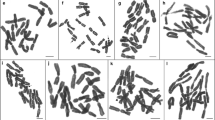Abstract
Morphological variation for the NOR chromosome was studied for four half-siblings of a sexual outbreedingTaraxacum, for three siblings of the obligate agamospermT. pseudohamatum, and for two individuals of the agamospermT. brachyglossum. No rearrangement was detected for the 113 chromosomes of sexuals, or for 41 chromosomes of two agamospermous individuals. In the other three agamospermous individuals, 3/16, 5/50, and 5/20 chromosomes showed evidence of chromosomal rearrangement. The majority of rearrangement events (10/13) occurred to the satellite rather than to the body of the NOR-chromosome. It is considered that such high levels of somatic chromosomal rearrangement in agamospermousTaraxacum may be the result of activity by transposable genetic elements. This recombination may be of selective advantage to asexual plants which cannot generate genetic variability through the sexual process.
Similar content being viewed by others
References
Hughes, J., Richards, A. J., 1985: The inheritance of isozymes in sexualTaraxacum. — Heredity54: 245–249.
Malecka, J., 1965: Embryological studies inTaraxacum palustre. — Act. Biol. Crac.8: 223–235.
—, 1973: Problems in the mode of reproduction in microspecies ofTaraxacum sectionPalustria Dahlstedt. — Act. Biol. Crac., ser. Bot.,16: 37–84.
Maynard Smith, J., 1978: The evolution of sex. — Cambridge: Cambridge University Press.
Mogie, M., 1982: The status ofTaraxacum agamospecies. — Ph.D. thesis. — University of Newcastle upon Tyne.
—, 1985: Morphological, developmental and electrophoretic variation within and between obligately apomicticTaraxacum species. — Biol. J. Linn. Soc.24: 207–216.
—,Richards, A. J., 1983: Satellited chromosomes, systematics and phylogeny inTaraxacum (Asteraceae). — Pl. Syst. Evol.141: 219–229.
Oostrum, H. van, Sterk, A. A., Wijsman, H. J. W., 1985: Genetic variation in agamospermous microspecies ofTaraxacum sect.Erythrosperma and sect.Obliqua. — Heredity55: 223–228.
Richards, A. J., 1970: Hybridisation inTaraxacum. — New Phytol.69: 1103–1121.
—, 1973: The origin ofTaraxacum agamospecies. — Bot. J. Linn. Soc.66: 189–211.
—, 1986: Plant breeding systems. — London: Allen & Unwin.
—,Ford, H., 1985: Isozyme variation within and betweenTaraxacum agamospecies in single locality. — Heredity55: 289–291.
Author information
Authors and Affiliations
Rights and permissions
About this article
Cite this article
Richards, A.J. A comparison of within-plant karyological heterogeneity between agamospermous and sexualTaraxacum (Compositae) as assessed by the nucleolar organiser chromosome. Pl Syst Evol 163, 177–185 (1989). https://doi.org/10.1007/BF00936513
Received:
Revised:
Issue Date:
DOI: https://doi.org/10.1007/BF00936513




